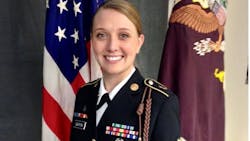Adopting substandard military preventive dentistry models is not the answer to solving the dental hygiene workforce shortage
What you’ll learn in this article
- Why the military dental model focuses on short-term readiness—not long-term prevention—and why that matters in civilian care settings
- How relying on minimally trained personnel for preventive procedures can result in missed disease, fragmented care, and delayed treatment
- What legal and ethical risks arise when underqualified providers perform duties outside their scope, especially regarding insurance billing and patient safety
- Why adopting military-style care models in civilian or Medicaid populations may deepen health inequities instead of solving access issues
A perspective from an Army Preventive Dentistry Specialist, now Registered Dental Hygienist
As the health-care industry increasingly recognizes oral health as a critical component of overall health and well-being, conversations around access, efficiency, and cost have intensified. While these discussions are necessary, they sometimes lead to the suggestion of adopting scaled down, “efficient” models that appear to work in other systems, such as the Army’s Preventive Dentistry Specialty model. However, what may appear to work in a battlefield-readiness framework is not appropriate for a civilian population.
Having served in the United States Army for nine years as a Dental Specialist and as a Preventive Dentistry Specialist and now practicing as a licensed Registered Dental Hygienist, I have firsthand experience in both systems. Over the last 15 years, my career has spanned military, academic, and civilian health-care environments. I have worn many hats and have worked as a dental assistant, preventive dentistry specialist, expanded duties dental assistant, clinical care coordinator, and RDH. I've led transitions within practices, managed clinical training, and built and operated a forward mobile dental clinic in Afghanistan. I have remained flexible in the face of change throughout my career, and I have learned what works and what does not. While the military dental model has a clear purpose within its unique environment, it is not designed to support lifelong oral health, and it should not be used as a template for civilian care.
Military dentistry: Efficient by necessity, not by design
The Army dental mission is primarily focused on ensuring that service members are “deployable” and to reduce noncombat dental casualties during deployment or other assigned missions.1 In the Army, this metric is referred to as readiness and is tracked through the Medical Protection System (MEDPROS).2 The priority is immediate or urgent interventions to prevent dental emergencies in combat zones. It does not emphasize long-term prevention or the comprehensive management of chronic oral diseases.
Despite these known limitations, there have been recent public endorsements of implementing military-style models in civilian care.
In a 2025 episode of the Straight Up with Steph podcast, American Dental Association President Brett Kessler, DDS, stated, “If it is good enough for our soldiers in the military and battle ready, I think we could do this [in] the public too.”3 While this sentiment may be rooted in a desire to improve access, it reflects a fundamental misunderstanding of both the military’s dental mission and the broader needs of civilian populations.
The origins of the Army’s Preventive Dentistry Specialist program date back to the 1960s, with formal training courses first appearing in 1961. However, the designation became more structured in the early 2000s and was officially recognized under the updated 68E Dental Specialist Military Occupational Specialty (MOS) in 2006.4 The expanded preventive role was implemented largely in response to a persistent shortage of licensed dental hygienists in military settings and the increasing demand to keep large troop populations dentally deployable. Rather than invest in expanding the number of licensed providers, the Army created a preventive function staffed by enlisted personnel with limited training.
While this model addressed immediate staffing gaps and increased the volume of basic preventive services, it has not led to measurable improvements in patient outcomes. Chronic conditions often go unmanaged, and many patients receive fragmented care or are deferred to delayed recall cycles. This model was a logistical solution to a personnel issue—not a clinical strategy rooted in evidence-based prevention.
Training to become a Preventive Dentistry Specialist (identified as “X2”) in the Army consists of a 12-week course that includes training in oral hygiene prophylactic procedures, applying pit and fissure sealants to the teeth, evaluating dental radiographs, and cleaning and sterilizing dental instruments and equipment.5 The clinical scope of an X2 includes performing basic prophylactic services (D1110), applying topical fluoride varnish, applying pit and fissure sealants, and providing oral hygiene instructions. Their clinical work is limited to patients who present with a Periodontal Screening and Recording (PSR) score of 0 to 2. If a patient shows signs of radiographic calculus or clinical indicators of periodontal disease, they are considered outside the X2’s scope of practice. In those cases, the patient typically receives a full-mouth debridement, or FMD (D4355), to remove the bulk of deposits and is then scheduled for a follow-up visit with a civilian RDH for comprehensive periodontal charting, diagnosis, and treatment planning.
These structural limitations are also compounded by the demographics of the military patient population. Many service members enter military service with limited education, a low dental IQ, low motivation for oral self-care, and inconsistent access to preventive services. This often results in heavy calculus buildup, gingival inflammation, and early to moderate periodontal disease, even among young, otherwise healthy individuals. Truly “healthy” patients, with minimal clinical findings and excellent home-care habits, are rare. Yet the system is designed for high-volume throughput and relies heavily on minimally trained personnel. As a result, patients with complex needs are often inadequately assessed and treated, leading to worsening conditions that could have been prevented with early intervention.
The recall standard in the Army is annual for most service members, regardless of their risk status.2 More frequent recall is typically assigned to patients diagnosed with active periodontal disease and those in periodontal maintenance, where they may be on a three-, four-, or six-month recall. However, access to specialty care is limited. A referral to a periodontist requires that the disease be advanced, and the patient must undergo a screening process before the case is accepted. Full-mouth periodontal charting is not routinely performed unless the patient is actively being treated by or referred to a periodontist, leaving many early cases undocumented and untreated.
There is a demand for productivity in Army dentistry, as with any health-care practice that is following metrics, with an emphasis on meeting readiness as their metric and processing as many patients as possible in a limited time frame. This focus on volume often comes at the expense of clinical thoroughness, individualized care, and early disease management. Patients who need more time, deeper assessments, or multiple visits are frequently deferred until their next recall cycle, by which time conditions may have progressed.
Ultimately, dental hygiene care in the Army is structured around volume, compliance, and operational readiness. It is not built on a foundation of personalized, relationship-based care. The emphasis on speed and documentation often replaces thorough clinical evaluation, tailored patient education, and consistent follow-up. These are elements that are essential for effective, long-term oral health care.
Civilian dentistry requires higher standards
In contrast to the military model, civilian RDHs operate within a care framework that is patient-centered, evidence-based, and prevention-focused. Most hygienists must graduate from accredited educational programs, meet rigorous licensure requirements, maintain continuing education, and adhere to protocols that emphasize early detection, risk assessment, and interprofessional collaboration. Their training equips them to provide comprehensive, individualized care grounded in both clinical science and ethical standards.
Efforts to expand access to care should never come at the expense of clinical integrity. Lowering the bar in the name of access is not a sustainable solution; it is a short-sighted compromise that often increases health disparities instead of reducing them. Patients in marginalized or underserved communities deserve the same standard of high-quality, evidence-based care as any other population. Increasing the number of patient encounters by using minimally trained providers may appear to address volume, but it frequently fails to resolve the root causes of poor oral health. True access means equitable access to quality care, not simply more care.
There are also significant insurance reimbursement and legal implications when undertrained providers are introduced into civilian practices under titles like “scaling assistants.” In the Army, if a patient seen by an X2 required treatment beyond their scope, a second appointment with an RDH was necessary. This often resulted in a full-mouth debridement (FMD) being coded. In the civilian sector, such a scenario could present challenges with insurance frequency limitations, especially if the patient had previously received a debridement within a limited time frame.
Kathy Forbes, BS, RDH, addressed this in RDH magazine, clarifying that the correct CDT code for services performed by a “scaling assistant” is D1999, the miscellaneous preventive code. However, once dental offices realize how low the reimbursement is for this code, there may be financial pressure to use higher-paying procedure codes that the assistant is not legally permitted to perform. This creates the risk of insurance fraud, placing both providers and practices in legal jeopardy and undermining the ethical foundation of dental care.6
Some states exploring or piloting “scaling assistant” models have justified their implementation by claiming they are meant specifically for their Medicaid population.7 This justification is deeply troubling. Patients with public insurance deserve the same level of care and clinical oversight as those with private coverage. Creating a separate, lower standard of care based on insurance status is not only discriminatory but also unethical and harmful to public trust. Moreover, allowing unlicensed or underqualified individuals to provide procedures outside their legal scope, even if billed under the supervising dentist’s National Provider Identifier (NPI), may constitute a violation of the False Claims Act. Submitting claims for services rendered by unqualified personnel is not only deceptive but also subject to legal action, including audits, penalties, and reputational harm.8,9 Innovation must never come at the expense of compliance, ethical standards, or patient safety.
Incorporating elements of the Army Preventive Dentistry Specialist model, such as authorizing undertrained personnel to perform procedures beyond their preparation, undermines the progress made in preventive oral health care. Although such measures may seem efficient on paper, in practice they often result in missed diagnoses, disease progression, and increased long-term health-care costs.
A system built for combat readiness is not built for wellness
I am proud of my military service and of what my colleagues and I accomplished under challenging conditions. The Army's dental model is effective in its own context, often operating in fast-paced, resource-limited, and unpredictable environments. However, we must not confuse a system designed for battlefield readiness with one designed to promote lifelong oral and systemic health. This model is necessarily structured around urgency, readiness, and resource conservation. It is reactive rather than preventive and prioritizes functionality over long-term health outcomes.
In contrast, a patient-centered care model emphasizes individualized treatment, early intervention, shared decision-making, and continuity of care. It values not only clinical outcomes, but also the patient's experience, understanding, and participation in their own oral health. Civilian dental care is built on these principles, recognizing that lasting wellness is achieved through education, consistent maintenance, and evidence-based intervention, not rushed procedures or one-size-fits-all protocols. A true patient-centered model requires time, training, and a qualified dental workforce, not short-term fixes or improvised solutions adapted from military structures.
Rather than adopting stripped-down care models, we should focus on strengthening access to the systems that work. This includes increasing support for licensed dental hygienists, investing in preventive services in underserved areas, improving clinical infrastructure, and fostering interprofessional care teams.
Conclusion
The future of oral health care should be guided by clinical excellence, ethical integrity, and a firm commitment to health equity. Importing elements of the military or, specifically, the Army Preventive Dentistry Specialist model, especially those designed for high-volume, low-touch care, poses a real threat to those principles. What may be efficient in the context of combat readiness is not appropriate in environments where prevention, patient education, and continuity of care are essential to long-term wellness.
Rather than lowering our expectations or expanding the responsibilities of undertrained personnel, we must advocate for solutions that enhance the quality of care for all. This includes investing in licensed dental hygienists, supporting integrated and interprofessional care models, increasing access in underserved communities, and leveraging innovation without sacrificing ethics or clinical safety.
Patients, regardless of insurance status, zip code, or background, deserve thoughtful, individualized care that recognizes the deep impact of oral health on their overall health and quality of life. Cutting corners in the name of cost or access will only lead to a system where preventable conditions become chronic, and underserved populations are treated with a lower standard of care.
Let us resist the temptation to adopt what is simply fast or familiar and instead commit to what is right. We must hold the line on standards, protect the integrity of our profession, and demand that every patient receives care worthy of their trust.
Disclosure: The views and opinions presented herein are those of the author and do not necessarily represent the views of DoD or the Army. Appearance of, or reference to, any commercial products or services does not constitute DoD or Army endorsement of those products or services. The appearance of external hyperlinks does not constitute DoD or Army endorsement of the linked websites, or the information, products or services therein.
Editor’s note: This article first appeared in Clinical Insights newsletter, a publication of the Endeavor Business Media Dental Group. Read more articles and subscribe.
References
- Army Regulation 40-35 Medical Services: Preventive Dentistry and Dental Readiness. 2025. https://milreg.com/File.aspx?id=6
- Army Regulation 600-8-101 Personnel Readiness Processing. https://milreg.com/File.aspx?id=1326
- Workforce shakeups & the future of dentistry with ADA President. Straight Up With Steph podcast. YouTube. June 9, 2025. https://www.youtube.com/watch?v=Oj3nL0V2ASo&list=PLMqvRkdl4s6FvkLIlYThqWX2b5lnmTkKb&index=4
- Highlights in the history of Army dentistry. The Free Library. 2015. https://www.thefreelibrary.com/Highlights%2Bin%2Bthe%2Bhistory%2Bof%2BArmy%2Bdentistry.-a0253627594?utm_
- S. Army Medical Department Center and School Course Catalog 2018. https://medcoeckapwstorprd01.blob.core.usgovcloudapi.net/pfw-images/dbimages/AMEDDC&S%20Catalog%20FY18%20draft%20as%20of%2014%20SEPT%202017.pdf
- Forbes KS. Are D1110/D1120 the proper CDT procedure codes for oral preventive assistants/ scaling assistants? RDH. July 1, 2025. https://www.rdhmag.com/patient-care/dental-coding/article/55300647/are-d1110-d1120-the-proper-cdt-procedure-codes-for-oral-preventive-assistants-scaling-assistants
- Anderson O. Arizona oral preventive assistants bill becomes law. ADANews. April 3, 2025. https://adanews.ada.org/ada-news/2025/april/arizona-oral-preventive-assistants-bill-becomes-law/
- The False Claims Act: A Primer. Justice.gov. 2010. https://www.justice.gov/sites/default/files/civil/legacy/2011/04/22/C-FRAUDS_FCA_Primer.pdf
- Federal False Claims Act. Dentist’s Advantage. 2025. https://www.dentists-advantage.com/Prevention-Education/Risk-Alerts/Risk-Alerts-Index/Content/FEDERAL-FALSE-CLAIMS-ACT
About the Author

Alana Hall, MHA, RDH
Alana Hall, MHA, RDH, is a mission-driven dental professional with over 15 years of experience in military, academic, and civilian dental settings. A U.S. Army veteran with nine years of service and a deployment to Afghanistan, she now practices as a Registered Dental Hygienist. Alana holds degrees in dental hygiene, business administration, and health-care administration, and is passionate about patient-centered care, interdisciplinary collaboration, and improving health-care delivery through leadership, education, and mentorship. Contact her at [email protected].

